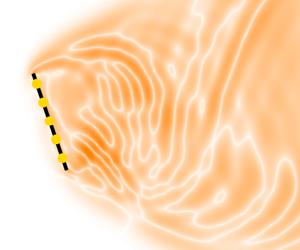当前位置:
X-MOL 学术
›
J. Fluid Mech.
›
论文详情
Our official English website, www.x-mol.net, welcomes your feedback! (Note: you will need to create a separate account there.)
Leveraging reduced-order models for state estimation using deep learning
Journal of Fluid Mechanics ( IF 3.7 ) Pub Date : 2020-06-09 , DOI: 10.1017/jfm.2020.409 Nirmal J. Nair , Andres Goza
Journal of Fluid Mechanics ( IF 3.7 ) Pub Date : 2020-06-09 , DOI: 10.1017/jfm.2020.409 Nirmal J. Nair , Andres Goza

|
State estimation is key to both analyzing physical mechanisms and enabling real-time control of fluid flows. A common estimation approach is to relate sensor measurements to a reduced state governed by a reduced-order model (ROM). (When desired, the full state can be recovered via the ROM). Current methods in this category nearly always use a linear model to relate the sensor data to the reduced state, which often leads to restrictions on sensor locations and has inherent limitations in representing the generally nonlinear relationship between the measurements and reduced state. We propose an alternative methodology where a neural network architecture is used to learn this nonlinear relationship. Neural network is a natural choice for this estimation problem, as a physical interpretation of the reduced state-sensor measurement relationship is rarely obvious. The proposed estimation framework is agnostic to the ROM employed, and can be incorporated into any choice of ROMs derived on a linear subspace (e.g., proper orthogonal decomposition) or a nonlinear manifold. The proposed approach is demonstrated on a two-dimensional model problem of separated flow around a flat plate, and is found to outperform common linear estimation alternatives.
中文翻译:

使用深度学习利用降阶模型进行状态估计
状态估计是分析物理机制和实现流体流动实时控制的关键。一种常见的估计方法是将传感器测量与由降阶模型 (ROM) 控制的简化状态相关联。(需要时,可以通过 ROM 恢复完整状态)。该类别中的当前方法几乎总是使用线性模型将传感器数据与简化状态相关联,这通常会导致对传感器位置的限制,并且在表示测量值和简化状态之间的一般非线性关系方面具有固有的局限性。我们提出了一种替代方法,其中使用神经网络架构来学习这种非线性关系。神经网络是这个估计问题的自然选择,作为简化状态传感器测量关系的物理解释很少是明显的。所提出的估计框架与所采用的 ROM 无关,并且可以合并到在线性子空间(例如,适当的正交分解)或非线性流形上导出的任何 ROM 选择中。所提出的方法在围绕平板的分离流的二维模型问题上得到了证明,并且被发现优于常见的线性估计替代方案。
更新日期:2020-06-09
中文翻译:

使用深度学习利用降阶模型进行状态估计
状态估计是分析物理机制和实现流体流动实时控制的关键。一种常见的估计方法是将传感器测量与由降阶模型 (ROM) 控制的简化状态相关联。(需要时,可以通过 ROM 恢复完整状态)。该类别中的当前方法几乎总是使用线性模型将传感器数据与简化状态相关联,这通常会导致对传感器位置的限制,并且在表示测量值和简化状态之间的一般非线性关系方面具有固有的局限性。我们提出了一种替代方法,其中使用神经网络架构来学习这种非线性关系。神经网络是这个估计问题的自然选择,作为简化状态传感器测量关系的物理解释很少是明显的。所提出的估计框架与所采用的 ROM 无关,并且可以合并到在线性子空间(例如,适当的正交分解)或非线性流形上导出的任何 ROM 选择中。所提出的方法在围绕平板的分离流的二维模型问题上得到了证明,并且被发现优于常见的线性估计替代方案。



























 京公网安备 11010802027423号
京公网安备 11010802027423号